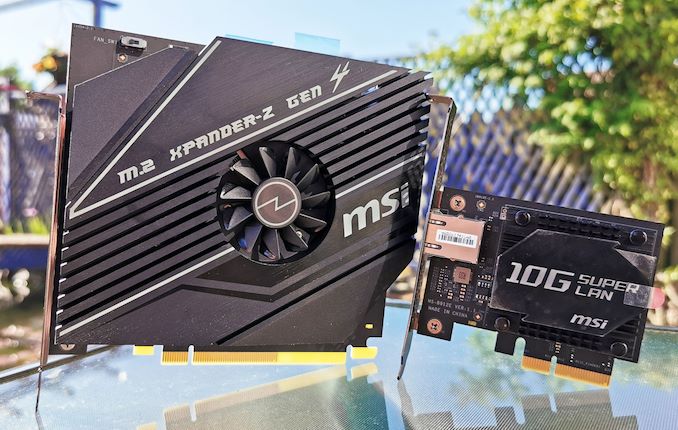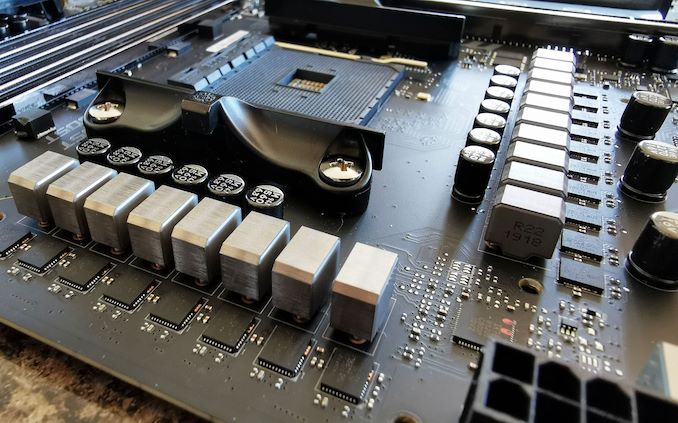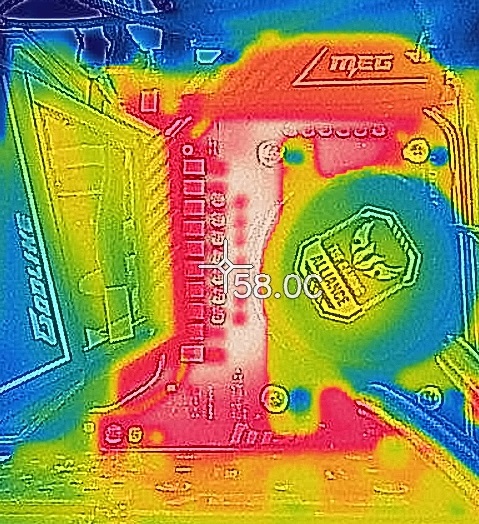The MSI MEG X570 Godlike Motherboard Review: Thor's Flagship
by Gavin Bonshor on August 28, 2019 12:00 PM EST- Posted in
- Motherboards
- AMD
- MSI
- 10G Ethernet
- Ryzen
- PCIe 4.0
- Ryzen 3000
- X570
- X570 Godlike
- MEG
MSI MEG X570 Godlike Conclusion
The MSI MEG X570 Godlike is an E-ATX motherboard which sits at the top of MSI's X570 product stack. It has a current price tag of $700 which puts it as one of the most expensive X570 models so far, and on paper it is one of the most feature-packed of all the X570 models. Other models that compete with this in terms of price point are the ASUS ROG Crosshair VIII Formula ($700), and the GIGABYTE X570 Aorus Xtreme ($700).
On offer is four full-length PCIe 4.0 slots which operate at x16, x8/x0/x8, and x8/x4/x4, while the bottom slot is locked to PCIe 4.0 x4. The MSI MEG X570 Godlike is the only X570 model with four full-length slots and as a consequence, has no PCIe 4.0 x1 slots. Its storage capabilities are also impressive with three PCIe 4.0 x4 M.2 slots on the board, with two additional PCIe 4.0 x4 drives due to the Xpander-Z Gen4 add-on card in the accessories bundle. On top of this, there are six SATA ports with support for RAID 0, 1, and 10 arrays.
Not only is the rear panel heavily packed with connections including three USB 3.1 G2 Type-A, one USB 3.1 G2 Type-C, and two USB 3.0 G1 Type-A ports, but the accessories bundle is also comprehensive with an Aquantia AQC107 10 G Super LAN card included; the other notable inclusion is six red and black braided SATA cables. Also included on the rear panel is a Flash BIOS and clear CMOS button which are very handy to have. A trio of Killer Networking powered ports including two Ethernet ports powered by an E3000 2.5 G and E2600 Gigabit NIC, but there is also an AX1650 Wi-Fi 6 802.11ax wireless interface which provides users with BT 5.0 connectivity too. Onboard audio is also boosted by the inclusion of an ESS 9018 Sabre DAC driven 6.3 mm headphone output, with a Realtek ALC1220 codec each for the front panel audio connector, and the five 3.5 mm jacks and S/PDIF optical output.
A reoccurring theme throughout the analysis of the MSI MEG X570 Godlike is the quality of the componentry, and its 16-phase power delivery as impressive as any board MSI has released over the last five years. The power delivery is using an International Rectifier IR35201 running at 7+1, with fourteen TDA21472 70 A power stages doubled up with seven IR3599 doublers. On the SoC section, there are four TDA21472 70 A power stages which are interestingly operating from a single IR3599 doubler running in quad mode; not exactly why MSI is using four power stages for the SOC when just two would have been suitable. The MSI X570 Godlike also boasts an impressive number of 4-pin fan headers with a total of nine splits into one for a CPU fan, one for a water pump, and seven for chassis fans.
On the performance front, the MSI MEG X570 Godlike performed consistently well throughout our CPU and gaming test suites. Power consumption was interesting in our testing with consistently higher than normal power draw in both idle and long idle power states, but matched other boards at peak load. This high idle power is likely due to the sheer number of controllers onboard.At full load, it performed on par with the MSI MEG X570 Ace which either shows the inefficiency of MSI's models at full-load; for reference, the ASUS Pro WS X570-Ace was a good 8 Watts better off at full load.

The MSI MEG X570 Godlike has an impressive accessories bundle
The overclocking performance was fruitful when done manually, with the 14-phase CPU power delivery and firmware doing its job well. MSI's Game Boost overclocking profiles on the other hand in our testing proved woefully inept with very high CPU VCore which in turn, put immense pressure on our 240 mm AIO CPU cooler on the testbed. MSI has reached out to us and stated that this issue will be addressed in the next firmware update. On a more positive note in our new power delivery thermal testing, the MSI MEG X570 Godlike performed very well with our overclocked Ryzen 7 3700X. The large power delivery heatsink is connected to the actively cooled X570 chipset heatsink via an aluminium heat pipe which seems to work very well with a maximum load temperature on the power delivery of 59°C from the integrated sensor, while our external probe on the rear recorded a maximum temperature of 61°C.
Overall the MSI MEG X570 Godlike is highly impressive and is the kind of flagship to get excited about. A lot of the features are overkill and add considerable expense such as the customizable OLED panel, the bolstered onboard audio and four full-length PCIe 4.0 slots. The majority of users aren't going to come close to using all of the Godlike's traits, which does bring questions about who exactly is buying a flagship motherboard at this price. Nonetheless, it is clear that MSI's Godlike makes a bold statement that MSI is in business when it comes to its X570 product design.
AnandTech Ryzen 3000 CPU and X570 Motherboard Coverage
- The AMD X570 Motherboard Overview: Over 35+ Motherboards Analyzed
- The MSI MEG X570 Ace Motherboard Review: Ace in the Hole at $369
- The AMD 3rd Gen Ryzen Deep Dive Review: 3700X and 3900X Raising The Bar
- AMD 16-Core Ryzen 9 3950X: Up to 4.7 GHz, 105W, Coming September
- AMD Zen 2 Microarchitecture Analysis: Ryzen 3000 and EPYC Rome
- AMD Ryzen 3000 Post-Review BIOS Update Recap: Larger ST Gains, Some Gains, Some Losses













116 Comments
View All Comments
oynaz - Saturday, August 31, 2019 - link
I actually prefer more cores to faster cores in my DAW. Each effect bus, or track, cannot be split into multiple cores, true, but you usually quite a few buses going.inighthawki - Friday, August 30, 2019 - link
GamingSweetbabyjays - Thursday, August 29, 2019 - link
In a professional setting, where you are doing thread intensive workloads, and IT is not cool with you overclocking...then yes, I totally agree 3900x makes way more sense."use less power overall" ? 9900k has a TDP of 95W, while the 3900x has a TDP of 105W, Additionally the Z390 chipset has a TDP of 6W while the X570 has a TDP of 11W. Now I know there is a discrepancy between how AMD and Intel measure TDP, so the numbers at face value may not be telling the whole story. That said, I would be very interested to see overall system power draw for both to test the veracity of your statement.
AshlayW - Thursday, August 29, 2019 - link
Oh boy, you actually think the 9900K uses 95W? Joke's on you pal, that's at 3.6 GHz. At full turbo clocks the 9900K uses 150-200W. Ryzen 3000 is almost twice the performance per watt in some scenarios.Trikkiedikkie - Saturday, August 31, 2019 - link
With the 3900 having many things inside the processor, whereas the 9900 has extra chips needed. And Intel's numbers only count for baseclockSweetbabyjays - Thursday, August 29, 2019 - link
"trounce it with it's higher core-count parts in multi-threaded scenarios." Aside from some synthetic benchmarks, I suggest looking at the puget systems website for professional benchmarks, if you're looking for more real world professional performance scenarios.The 12 core part is better in some(in some the 9900k is better) scenarios, but rarely(if ever) by more than 10%. Perhaps your definition of "trounce" is different from mine thought.
If you're gaming much more often than you are working/creating the increased core count really wont improve your overall computing experience, if at all.
Oliseo - Thursday, August 29, 2019 - link
This is true. But the argument remains, just how many people actually use highly mutli-threaded scenarios.I'd wager if you got a venn diagram of gamers and content creators, the content creators would simply be a small spot on the very large gaming circle.
I know a lot of gamers, yet I struggle to meet 3D cad designers or Film Editors.
So yes, you're right, AMD will trounce Intel in that respect. But until we get games using more than 8 cores, the majority of people will not be better off because they simply don't need those extra cores as they don't run any software that can make use of them.
And that goes for AMD folks wanting to get the AMD chips as well.
Trikkiedikkie - Saturday, August 31, 2019 - link
Gaming is soo small compared to people doing actual work.AshlayW - Thursday, August 29, 2019 - link
$150 more, for 10% higher single core performance when both CPUs already have extremely good single core performance, and you can place a 4700X in the same motherboard next year that will have even higher single core than the 9900K? Seriously people, consumer stupidity is why Intel is still selling CPUs.Trikkiedikkie - Saturday, August 31, 2019 - link
Single core is soooo last century.Only people that have very little serious work apart from Adobe want that.